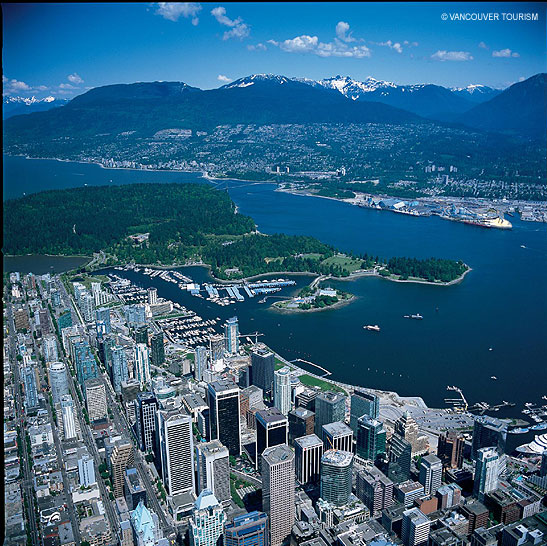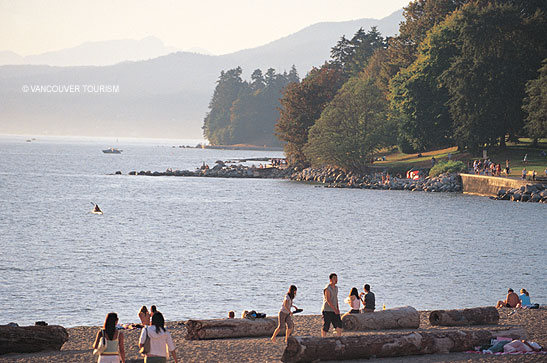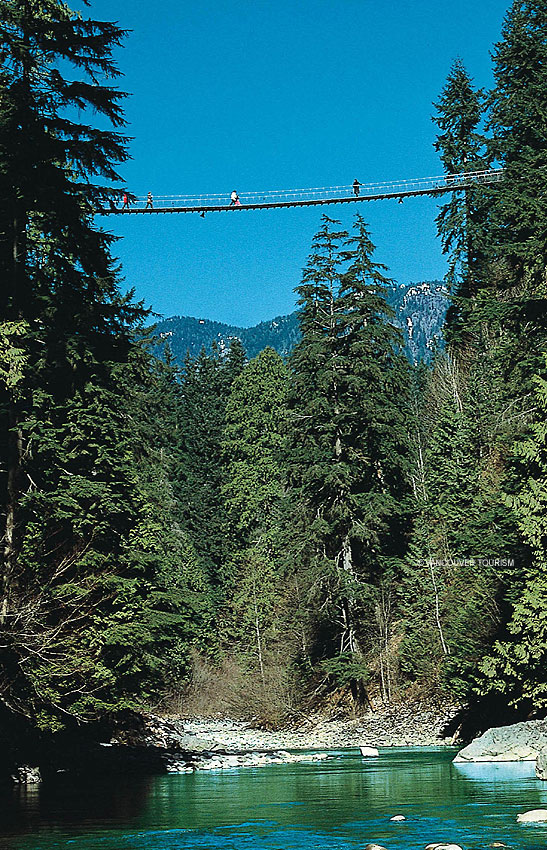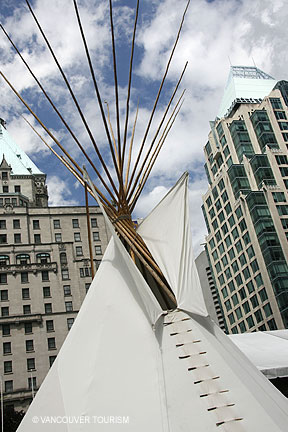 |
 |
|
 |

|
Vancouver, British Columbia
As the years marched on, I would return to Vancouver often, and the city never failed to engage me. Yes, Vancouver has changed; Robson street, once coined 'Robsonstrasse' - where little European bakeries and delis lined the street - has evolved into the city's hippest boutique street, and now coffee is the preferred beverage, with more than 75 Starbucks in a city proper of 611,869, but it will always be my special place just on the other side of the border. The world has discovered it too; Vancouver was voted the "Best City in the Americas" for 2004, 2005 and 2006 by Condé Nast Traveler magazine. It all makes perfect sense to me, for this is a city that really does - and always will - live up to its accolades.
Gastown is brimming with tourists, and some locals will suggest you shouldn't even bother with it, but this is the historic center of Vancouver and a visit is essential. : Named after "Gassy Jack," who opened a saloon in 1867 for forestry workers on the shore of Burrard Inlet, Gastown still retains much of its old flavor. Established in 1971 as a historic district, it is today a mix of renovated brick and stone buildings, vintage street lamps, tourist shops, galleries, restaurants and pubs. 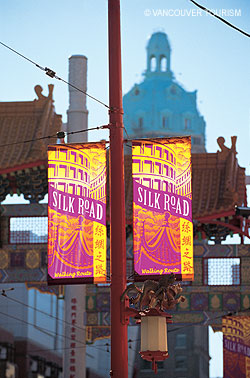 Chinatown ChinatownVancouver's Chinatown is the second largest in North America, but most importantly it is here to serve the city's largest ethnic group - 30% of Vancouver households speak Cantonese or Mandarin as a first language - and not its tourists. Located on the edge of downtown, it has been the center of Chinese culture in Vancouver for more than a century, and part of its very charm is its sense of authenticity and lack of souvenir shops and tourist kitsch. Robson Street Yaletown
While much smaller than Chinatown, these three enclaves south of Grandville Bridge make an excellent mini excursion out of the downtown core. KitsilanoAlong West Broadway, the Kitsilano neighborhood shares the dual identity of being both a hip, counter-culture district - Greenpeace was founded here back when it was Canada's answer to Haight-Ashbury - and the site of its informal 'Greektown'. Among its numerous shops you'll find plenty of places to get your fill of Greek delicacies. Little Italy A short drive down 1st Ave leads to Commercial Drive, site of Little Italy. Home to regional Italian restaurants, robust cafes, delis, shops and even a ravioli factory, it makes a fun street to stroll on. Little India Several miles to the south, along Main Street and 49th Avenue, rests a two-block stretch of businesses that make up Little India. It's a good place to shop for Indian music, searching the Punjabi Market for the best deal on masala sauce, or having an Indian buffet lunch.
Just Outside of Town Capilano Suspension BridgeConsidered Vancouver's oldest tourist attraction, the 450 feet-long Capilano Suspension Bridge is located in a lush twenty-seven acre West Coast Rainforest Park, 230 feet above the Capilano River. Originally made of hemp rope and cedar planks, today's bridge is constructed of reinforced steel, safely secured in 13 tons of concrete on either side of the canyon. A walk across this swaying footbridge is more thrilling than a trip to an amusement park, and certainly more beautiful. A new addition to the park is Treetops Adventure, which features seven separate suspension bridges, unobtrusively connected among the evergreens. Seeing the park from 100 feet above the ground gives participants quite literally a tree-like perspective.
For further information about travel to Vancouver, contact TourismVancouver.com |
* * * * Ed, The photos are spectacular. I can envision many a romantic novel inspired
by these majestic sceneries. Makes me want to do a little more research
on Norway. John Lenon must have been one of the converts when he wrote
"Norwegian Woods." * * * * Peter, Thanks for the kind words and taking the time to write. Indeed, Norway
was paradise on earth, and I dream of returning again and again. You
had a funny line about John Lennon being so inspired by the beauty of
Norway that he composed the song, "Norwegian Wood." If I'm
not mistaken, his reference to "Norwegian Wood" is just that:
an inexpensive pine wood from Norway that was becoming popular in the
UK. I did read somewhere, though, that "I Want to Hold Your Hand"
was inspired by Norwegian fjord trek. Ed
Ed, Reading Peter's implication that "Norwegian Wood" was based on a trip that John Lennon took to Norway led me to do some research. According to Paul McCartney at a press conference in Los Angeles: 'Peter Asher [brother of McCartney's then-girlfriend Jane Asher] had just done his room out in wood, and a lot of people were decorating their places in wood. Norwegian wood. It was pine, really, just cheap pine. But it's not as good a title, is it, "Cheap Pine"? It was a little parody, really, on those kind of girls who, when you'd get back to their flat, there would be a lot of Norwegian wood. It was completely imaginary from my point of view, but not from John's. It was based on an affair he had. She made him sleep in the bath and then, finally, in the last verse, I had this idea to set the Norwegian wood on fire as a revenge. She led him on and said, "You'd better sleep in the bath." And in our world, that meant the guy having some sort of revenge, so it meant burning the place down....' Of course, just cause it's on the 'net doesn't mean it's true.
Weird piece on Copenhagen (Cosy in Copenhaggen). Do you think now that
Keefer’s in the slammer in Glendale for DWI he’s experiencing
any hygge? I bet some of those jailbirds would like to see how touch
he is. --- Adam S., Glendale CA
I loved your intro and the way you set up the article. It immediately set the tone of an action-paced adventure. I imagined Annette as a spy in a trenchcoat feeding you top secret information. I'm surprised you didn't get lost. Do they speak English over there? Are the street signs in English? Does a GPS work over there? I never heard of "hygge" but, like you, I think I've felt that sensation everytime the cold wind blows here in South Pasadena, CA. When I sit beside a warm fire, sipping my hot chocolate, I will remember this article. Thanks! --- Peter Paul, South Pasadena, CA
|
![]()
Stay tuned.
This site is designed and maintained by WYNK Marketing. Send all technical issues to: support@wynkmarketing.com

|











